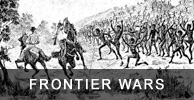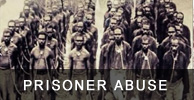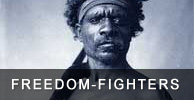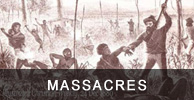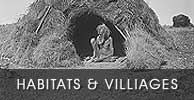Sound files of the Frontier Wars - The First Nations fight back
In his new book, The Story of Australia's People, Geoffrey Blainey writes that one of the reasons aboriginal tribes didn’t effectively resist European settlement was that they were militarily weak. Indigenous tribes often fought with each other rather than launch coordinated attacks against settlers, However, Dr Ray Kerkhove an expert in indigenous history, who has done new research on indigenous warfare in Queensland in the 19th century has an a very different view.
The convicts left to rot in Van Diemen's Land (Tasmania) didn't all hail from Britain. There were Australian Aboriginal freedom fighters, South African and even Moari convicts. If you hang the Freedom Fighters (Trouble-makers) you are left with a body (evidence), but if you transport them to a penal colony, they can disappear without trace. Gamaregal warrior, Musquito led a resistance against settlers in the Hawkesbury until he was caught and sent to Norfolk Island and then Van Diemen's Land. More: https://audioboom.com/boos/2760885-troublesome-natives-rotting-in-the-pe...
The colony of Port Phillip was just eight years old when it held its first execution. The first people hanged in 1842 were two Aboriginal men from Tasmania. How did they come to be on the mainland? The story of Tunnerminnerwait and Maulboyheneer is shocking, exciting, tragic and moving. Their tumultuous and short lives tell us so much about frontier conflict and the early colonial history of Tasmania and Victoria. The two men were among a larger group of people, including Truganini, who were brought to the mainland by George Augustus Robinson, to act as intermediaries.
One of the most familiar names in the story of Australian colonisation is that of the Tasmanian Aboriginal woman 'Truganini'. But for most people the story begins and ends with a single, very famous photo, along with a label describing her simply as the last of the full-blood Tasmanian Aborigines. Not only was that label deeply misleading, we now know that Truganini's life is one of the most significant foundation stories of European settlement in Australia. But there's still one story that few people know about and about which little has been written - it's the extraordinary tale of Truganini's time as a freedom fighter (named as a bushranger in this story). More: https://audioboom.com/boos/2696321-truganini-in-her-freedom-fighting-days
First Nations people from across Western Australia will travel to Rottnest Island, or Wadjemup, to remember their ancestors who were brought there in chains. The island's former prison, 19 kilometres from the Perth coastline, incarcerated thousands of people from as far as the Kimberley, Pilbara, Western Desert and across Nyungah lands. It's believed at least 370 and possibly up to 700 men and boys are buried in unmarked graves on the island, which is now a tourist destination. More: https://audioboom.com/boos/2563950-remembrance-day-at-wa-s-wadjemup-rott...
What do you think about recognition for the dealths of Aboriginal people during conflicts between them and white settlers? A University of Queensland academic has said that more than 65,000 Aboriginal people died in Queensland alone between 1788 and 1930 in the process of colonising Australia. Professor Raymond Evans has said that the Australian War Memorial should recognise it as a war. More: https://audioboom.com/boos/2342990-war-memorial-recognition-of-frontier-...
Cairns-based historian Timothy Bottoms has drawn a new map of Queensland, that places many more sites of massacres of Aboriginal people into the story than have ever been acknowledged before. And while he argues that this is a story of deep silences, what he demonstrates is how public and discussed these killings were in the nineteenth century. More: https://audioboom.com/boos/1507289-audio-snippet-the-thomas-davis-massac...
Five of the last Tasmanian Aboriginal people were shipped to the Victorian mainland to help the 'Aboriginal Protector' civilise the blacks - instead they gave the settlers such a fright, burning their houses and their money etc, that many of the settlers families left their 'stolen properties' and moved closer to Melbourne for protection. After a major hunting spree with mobs of police and settlers, they were finally caught and after a court case that they were not even allowed to speak at, the two male warriors ended up being the first hangings in Victoria. they were public hangings in a carnival atmosphere. More: https://audioboom.com/boos/2696299-victoria-s-forgotten-war-the-freedom-...
A Queensland based historian has branded the pioneering myth of the early white settlers as a lie. In his book Conspiracy of Silence, Doctor Timothy Bottoms claims that Australia has been let down by historians. Dr Timothy Bottoms - Interview: Paul Wyles, CAAMA Radio. More: https://audioboom.com/boos/1449912-audio-frontier-history-revisted-with-...
An outbreak of smallpox in Sydney in 1789 killed thousands of Aborigines and weakened resistance to white settlement. Chris Warren argues that the pandemic was no accident, but rather a deliberate act of biological warfare against Australia’s first inhabitants. More: https://audioboom.com/boos/2258763-smallpox-an-act-of-biological-warfare...
In 1902 the Boer War in South Africa drew to an end. The sovereign, anti-colonial, independent Republic leaders agreed to lay down their weapons, abandon their claims to independence and recognise Britain's Edward VII as their king. And so began the process of repatriating the 22,000 Australians who'd survived the distant war. But not everyone made it home. It's claimed 50 Aboriginal trackers were left behind because they were denied re-entry to Australia. More: https://audioboom.com/boos/1345281-50-aboriginal-trackers-left-behind-du...
For almost a century, tens of thousands of Indigenous Australians were forced to work for pastoral stations, missions and government reserves for little more than pocket money. Some have called it legalised slavery and are now fighting to recoup stolen wages. Between the 1860s and the 1970s, Aboriginal people of all ages were taken from their homes and sent to work on cattle and sheep properties all across Australia. More: https://audioboom.com/boos/2318112-did-legalised-slavery-exist-in-australia

